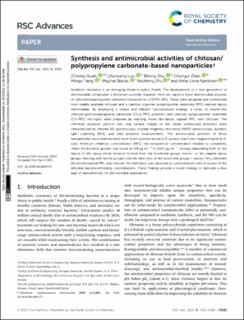| dc.contributor.author | Quan, Zhilong | |
| dc.contributor.author | Luo, Chunyang | |
| dc.contributor.author | Zhu, Bitong | |
| dc.contributor.author | Zhao, Chungui | |
| dc.contributor.author | Yang, Mingyi | |
| dc.contributor.author | Bjørås, Magnar | |
| dc.contributor.author | Zhu, Kaizheng | |
| dc.contributor.author | Kjøniksen, Anna-Lena | |
| dc.date.accessioned | 2021-05-28T13:52:30Z | |
| dc.date.available | 2021-05-28T13:52:30Z | |
| dc.date.created | 2021-03-15T12:37:57Z | |
| dc.date.issued | 2021 | |
| dc.identifier.citation | RSC Advances. 2021, 11 (17), 10121-10129. | en_US |
| dc.identifier.issn | 2046-2069 | |
| dc.identifier.uri | https://hdl.handle.net/11250/2756920 | |
| dc.description.abstract | Antibiotic resistance is an emerging threat to public health. The development of a new generation of antimicrobial compounds is therefore currently required. Here we report a novel antimicrobial polymer of chitosan/polypropylene carbonate nanoparticles (CS/PPC NPs). These were designed and synthesized from readily available chitosan and a reactive oligomer polypropylene carbonate (PPC)-derived epoxy intermediate. By employing a simple and efficient functionalized strategy, a series of micelle-like chitosan-graft-polypropylene carbonate (CS-g-PPC) polymers and chitosan–polypropylene carbonate (CS–PPC) microgels were prepared by reacting mono-/bis-epoxy capped PPC with chitosan. The chemical structure, particle size, and surface charge of the newly synthesized polymers were characterized by infrared (IR) spectroscopy, nuclear magnetic resonance (NMR) spectroscopy, dynamic light scattering (DLS), and zeta potential measurements. The antimicrobial activities of these nanoparticles were determined in both Gram-positive bacteria (S. aureus) and Gram-negative bacteria (E. coli). Minimum inhibitory concentration (MIC), the nanoparticle concentration needed to completely inhibit the bacterial growth, was found at 128 μg mL−1 to 1024 μg mL−1, strongly depending both on the nature of the epoxy-imine network formed from the functional groups (mono- or bis-capped epoxy groups reacting with amine groups) and the feed ratio of the functional groups (-epoxy/-NH2) between the functionalized PPC and chitosan. No hemolysis was observed at concentrations well in excess of the effective bacteria-inhibiting concentrations. These findings provide a novel strategy to fabricate a new type of nanoantibiotic for antimicrobial applications. | en_US |
| dc.language.iso | eng | en_US |
| dc.publisher | Royal Society of Chemistry | en_US |
| dc.rights | Attribution 3.0 Unported (CC BY 3.0) | |
| dc.rights.uri | https://creativecommons.org/licenses/by/3.0/ | |
| dc.title | Synthesis and antimicrobial activities of chitosan/polypropylene carbonate-based nanoparticles | en_US |
| dc.type | Peer reviewed | en_US |
| dc.type | Journal article | en_US |
| dc.description.version | publishedVersion | en_US |
| dc.rights.holder | © 2021 The Author(s). | en_US |
| dc.subject.nsi | VDP::Teknologi: 500::Kjemisk teknologi: 560::Farmasøytisk formulering og teknologi: 568 | en_US |
| dc.subject.nsi | VDP::Matematikk og Naturvitenskap: 400::Kjemi: 440::Legemiddelkjemi: 448 | en_US |
| dc.source.pagenumber | 10121-10129 | en_US |
| dc.source.volume | 11 | en_US |
| dc.source.journal | RSC Advances | en_US |
| dc.source.issue | 17 | en_US |
| dc.identifier.doi | 10.1039/d0ra09257f | |
| dc.identifier.cristin | 1898101 | |
| cristin.ispublished | true | |
| cristin.fulltext | original | |
| cristin.qualitycode | 1 | |

